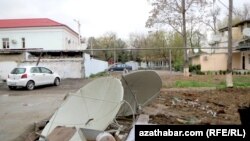The dismantling and removal of satellite dishes in Turkmenistan continues. That is not news; it’s been happening in the capital, Ashgabat, and surrounding areas for years now.
Many suspect the reason is the desire of the authorities to prevent the country's people from accessing outside information.
Officially, the satellite dishes were considered pockmarks, eyesores in the great white marble city.
But RFE/RL's Turkmen Service, known locally as Azatlyk, has learned that the campaign has picked up pace lately and been extended to areas far from Ashgabat, making it difficult to believe the removal of satellite dishes and antennas is anything other than an attempt to cut off Turkmenistan's people from contact with the outside world.
In April, Azatlyk correspondent Amanmyrat Bugaev went to the northern city of Dashoguz, where authorities made some half-hearted efforts to get rid of satellite dishes a couple of years ago. Bugaev said a new order went out recently to remove satellite dishes. The reason was the same as in Ashgabat -- beautification of the city -- and it is necessary in Dashoguz now, because that city was designated as the Commonwealth of Independent States' cultural capital for 2016.
Bugaev said the same thing was happening in the cities of Mary, in the southern Mary Province, and in Turkmenabat, in the eastern Lebap Province. "It's going on in all major cities," the Azatlyk correspondent said.
Bugaev also traveled to the western Balkan Province and said authorities were taking down satellite dishes in Balkanabat city. Bugaev said the removals were not confined to Balkanabat but extended to villages all around the city.
"Employees of the municipality who are removing antennas don't give any reason," he said. "Local people confronted the municipality workers and were told the antennas are ruining the beauty of the city and people were given a few days to take them down or else the municipality would do it."
In Ashgabat, some of those who lost their satellite dishes were offered the chance to subscribe to government cable packages. In some places there is a central antenna and people can connect to that. In both cases the selection of channels is limited.
Azatlyk has already received complaints from listeners in the Ashgabat area that access to some programs, including Azatlyk's, is impossible via government-owned antennas. Satellite connections have been one of the main means of receiving Azatlyk's broadcasts.
People in smaller cities of Turkmenistan are apparently not being offered any options. They are simply losing their satellite television links and are now confined to receiving Turkmen state television, which even the president has on occasion described as lacking in entertainment.
This latest wave of "beautification" does seem to show, however, that the intent of Turkmen authorities is, and always has been, to restrict the population to accessing information solely from state sources.






